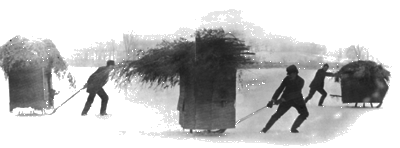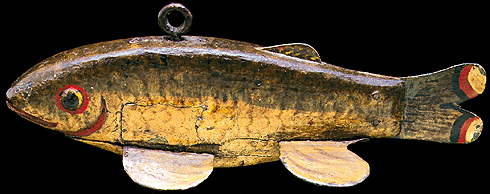|
New
York State
|
|||
|
|||
|
New York State fish decoys are among the first examples of the art known to be produced by non-indigenous people and generally date from the end of the 19th Century, when spearfishing was a highly popular sport in New York State. The sport became so popular that few examples date later than 1905, when ice-fishing was outlawed throughout New York because of concern over declining fish populations.
Maker
Unknown / Perch
Decoy  Maker
Unknown / Sucker Decoy,
Metal fins and leather tail, Lake Chatauqua area, last quarter of the 19th Century. Auctioned January 22, 2000 at Sotheby's/New York for $32,200, a new record for Icefishing Decoys. |
|||
|
As shown by the spectacular pieces above, New York State fish decoys are among the most prized of collectibles. Stylistically, they are instantly recognizable and seem related to Native American designs.
Maker
Unknown /
New York State Trout Decoy
By
the end of the 19th Century, styles had rigidified and the New York
State decoys were almost always made of wood, tended to be somewhat
somber in color and impressionistic in terms of both design and detail.
Generally, they are characterized by leather tails slotted into the
bodies and single piece fins which pass through the body and protrude
on either side. Harry
Seymour was the great master craftsman of
the New York decoys.
His elegant and sinuous carvings typify the New York Style and have
consistently set auction records.
Harry
Seymour / Perch Decoy
Harry
Seymour / Perch Decoy
The decoys below represent a cross section of the 19th Century New York, Lake Chautauqua ice fishing decoys and illustrate the general look, appearance and style.
Maker
Unknown /
New York State Perch Decoy
Maker
Unknown /
New York State Muskie Decoy
Maker
Unknown /
New York State Perch Decoy
Maker
Unknown /
New York State Perch Decoy
|









